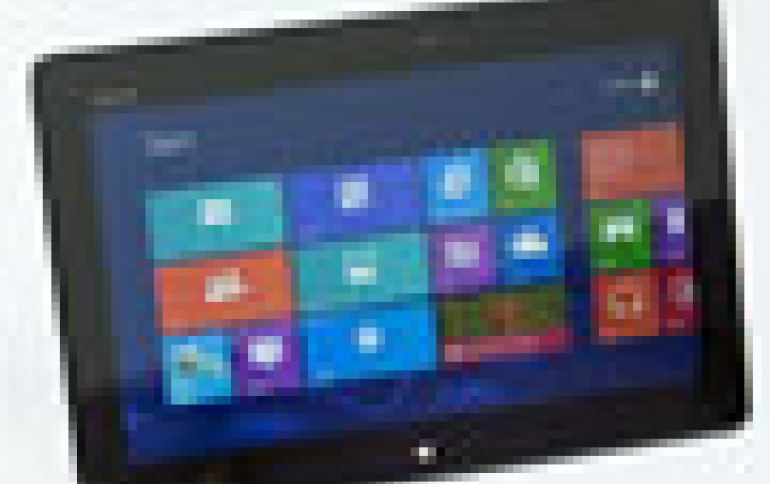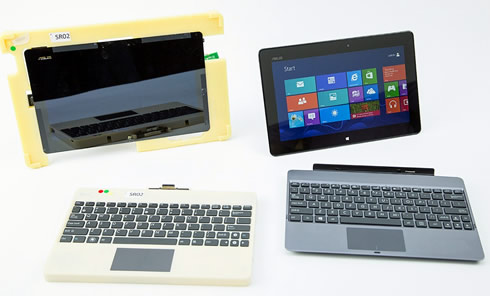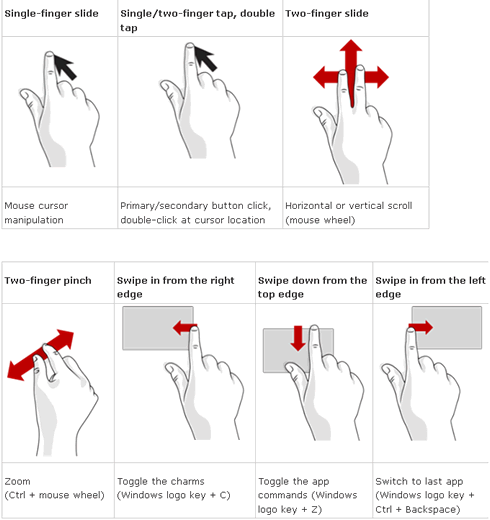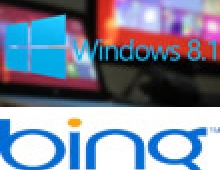
More Information On Microsoft Windows RT
Windows RT PCs will have consistent touch interactions, long battery life, connected standby, and are and light designs, according to Microsoft.
Windows 8 and Windows RT each reached the RTM milestone, and Microsoft today provided some details on the new OS for ARM-based PCs.
Microsoft has already annouced that Windows RT shares significant code with Windows 8. The company has collaborated with NVIDIA, Qualcomm, and Texas Instruments to deliver one Windows binary for all Windows RT SoC platforms. PC makers will provide Windows RT PCs as integrated, end-to-end products that include hardware, firmware, and Windows RT software. This means that Windows RT software will not be sold or distributed independent of a new Windows RT PC, as it relies on unique and integrated pairings of hardware and software.
Windows RT PCs will also connected standby, a scenario of having your PC be always on and always connected in the new connected standby state without excessively draining your battery, so that you have access to your important and up-to-date information whenever you need it. When your Windows RT PC is not in use, it will move into a new low-power mode that allows it to keep your data fresh and current while also not requiring a battery charge for days. And when you need your system, it will turn on in less than a second at the touch of a button. Microsoft focused on an aggressive whole system power modeling scenario that has allowed the company to better inform battery capacities to deliver all-day battery life with days of connected standby in thin and light designs.
Microsoft's preliminary measurements with an early production Windows RT PC showed that it could playback HD video for 8 hours to 13 hours, or remain in the connected standby mode for 320 hours to 409 hours.
These measurements are based on firmware still undergoing final optimizations, and the just released Windows RT RTM code. In this case, the PC was playing back in full screen a local HD video at full resolution with a screen brightness of 200 nits. It was also configured for one email account using the Microsoft network. Finally, these numbers are also influenced by the different PC form factors themselves, which include both tablets and laptops, screen sizes that vary from 10.1" to 11.6", and battery sizes spanning 25 Whr to 42 Whr.
Microsoft has also invested in design optimizations. For example, typical touch controller solutions were based on multi-chip solutions. By reducing those solutions to single-chip designs, the company achieved lower power usage and reduced thermals, which translated to smaller battery sizes and thinner and lighter designs. The typical weight and thicknesses of Windows RT models are the following:
Weight (g): 520g to 1200g
Length (mm): 263mm to 298mm
Width (mm): 168.5mm to 204mm
Height (mm): 8.35mm to 15.6mm
Below is a snapshot of an actual pre-release Windows RT PC, showing a very early engineering prototype and the evolution to its current form:

These single-chip solutions not only reduce power requirements, but they also provide performance optimizations that result in fast touch usage. The Windows RT PCs that Microsoft's partners will be delivering for the upcoming launch provide sampling rates of 100Hz per finger.
Microsoft said that its graphics core had also gone through extensive optimization. Besides the optimizations around power-efficient HD video playback, the core Windows RT UI animations achieve 60fps.
Microsoft also focused on enabling new scenarios in these Windows RT PCs. You will see NFC integration in some of the Windows RT launch PCs that open up fun and interesting things like tap to share. By simply tapping two NFC-enabled Windows RT PCs together, users can share photos, URLs, map directions, and anything else that Microsoft's software partners have designed into their Windows apps. And of course Windows RT natively supports a broad range of device scenarios such as USB mass storage, printing, audio/video peripherals, and more, along with connectivity through WWAN, Wi-Fi, Bluetooth, and USB.
Some Windows RT PCs come with full keyboard and touchpad solutions, whether removable/dockable or a traditional clamshell. Not only do these solutions provide additional battery capacity, but they also provide a new touchpad experience that incorporates Windows 8 gestures. Microsoft has incorporated native support in firmware to deliver fast gesture recognition. The touch gestures that will be natively supported are described in these two tables:

ARM-based PC designs have been already announced by Asus (Tablet 600 Windows RT,) and Microsoft (Surface RT.) Dell, Lenovo, and Samsung are also expected to announce Windows RT devices.
Microsoft has already annouced that Windows RT shares significant code with Windows 8. The company has collaborated with NVIDIA, Qualcomm, and Texas Instruments to deliver one Windows binary for all Windows RT SoC platforms. PC makers will provide Windows RT PCs as integrated, end-to-end products that include hardware, firmware, and Windows RT software. This means that Windows RT software will not be sold or distributed independent of a new Windows RT PC, as it relies on unique and integrated pairings of hardware and software.
Windows RT PCs will also connected standby, a scenario of having your PC be always on and always connected in the new connected standby state without excessively draining your battery, so that you have access to your important and up-to-date information whenever you need it. When your Windows RT PC is not in use, it will move into a new low-power mode that allows it to keep your data fresh and current while also not requiring a battery charge for days. And when you need your system, it will turn on in less than a second at the touch of a button. Microsoft focused on an aggressive whole system power modeling scenario that has allowed the company to better inform battery capacities to deliver all-day battery life with days of connected standby in thin and light designs.
Microsoft's preliminary measurements with an early production Windows RT PC showed that it could playback HD video for 8 hours to 13 hours, or remain in the connected standby mode for 320 hours to 409 hours.
These measurements are based on firmware still undergoing final optimizations, and the just released Windows RT RTM code. In this case, the PC was playing back in full screen a local HD video at full resolution with a screen brightness of 200 nits. It was also configured for one email account using the Microsoft network. Finally, these numbers are also influenced by the different PC form factors themselves, which include both tablets and laptops, screen sizes that vary from 10.1" to 11.6", and battery sizes spanning 25 Whr to 42 Whr.
Microsoft has also invested in design optimizations. For example, typical touch controller solutions were based on multi-chip solutions. By reducing those solutions to single-chip designs, the company achieved lower power usage and reduced thermals, which translated to smaller battery sizes and thinner and lighter designs. The typical weight and thicknesses of Windows RT models are the following:
Weight (g): 520g to 1200g
Length (mm): 263mm to 298mm
Width (mm): 168.5mm to 204mm
Height (mm): 8.35mm to 15.6mm
Below is a snapshot of an actual pre-release Windows RT PC, showing a very early engineering prototype and the evolution to its current form:

These single-chip solutions not only reduce power requirements, but they also provide performance optimizations that result in fast touch usage. The Windows RT PCs that Microsoft's partners will be delivering for the upcoming launch provide sampling rates of 100Hz per finger.
Microsoft said that its graphics core had also gone through extensive optimization. Besides the optimizations around power-efficient HD video playback, the core Windows RT UI animations achieve 60fps.
Microsoft also focused on enabling new scenarios in these Windows RT PCs. You will see NFC integration in some of the Windows RT launch PCs that open up fun and interesting things like tap to share. By simply tapping two NFC-enabled Windows RT PCs together, users can share photos, URLs, map directions, and anything else that Microsoft's software partners have designed into their Windows apps. And of course Windows RT natively supports a broad range of device scenarios such as USB mass storage, printing, audio/video peripherals, and more, along with connectivity through WWAN, Wi-Fi, Bluetooth, and USB.
Some Windows RT PCs come with full keyboard and touchpad solutions, whether removable/dockable or a traditional clamshell. Not only do these solutions provide additional battery capacity, but they also provide a new touchpad experience that incorporates Windows 8 gestures. Microsoft has incorporated native support in firmware to deliver fast gesture recognition. The touch gestures that will be natively supported are described in these two tables:

ARM-based PC designs have been already announced by Asus (Tablet 600 Windows RT,) and Microsoft (Surface RT.) Dell, Lenovo, and Samsung are also expected to announce Windows RT devices.



















